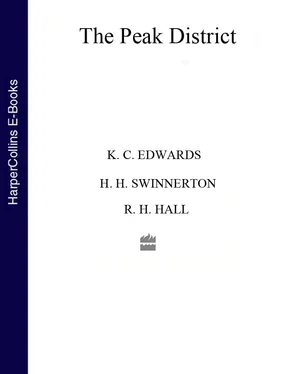In the uplands the limestone is almost uniform in character, but in the moorlands extremes meet and resistant grits lie in close juxtaposition with the much more easily weathered shales. This is illustrated in The Peak itself which is capped with a mighty slab of grit, several hundred feet thick, resting on a pedestal of shale. The slab forms a plateau bounded by steep rugged cliffs. The pedestal is flanked by slopes whose surface is roughened by landslips or broken by steps caused by the presence of occasional thin beds of grit.
The rock of the plateau is so porous that rain-water soaks into it rapidly and, percolating downwards, saturates the lower layers. This great slab of grit therefore functions as an underground reservoir having an impervious floor but is without retaining walls around its margins where, at the junction of the two kinds of rock, the water leaks slowly away and is lost. Within the grit the water flows freely through the fissures but elsewhere its flow is hindered as it seeps slowly through the fine pores of the rock. Unlike the water-table of an ordinary open-air reservoir, the surface of which is perfectly flat, that in the grit is heaped up in the centre and slopes thence in all directions.
Wherever a valley has been developed on the plateau deep enough for its floor to reach the water-table, water escapes and forms a stream flowing along the valley bottom. Elsewhere the plateau is dry and streamless.
At the base of the cliffs bounding the plateau water leaks away perpetually and, soaking into the adjoining shale, softens it to such an extent that it yields to the pressure of the overlying rock and is slowly squeezed out. The cliff, with its foundation thus weakened, eventually collapses and tumbles its fragments down the slopes. It is in this way that the slabs of rock which cap the highest grounds in the district have been and are being worn away gradually, so that large plateaux in time become small ones, e.g. Brown Hill and Stanton Moor, and small ones become conical peaks or pikes such as Win Hill near Hope and Oaker Hill near Matlock.
Where a crack or fissure running through the rock emerges at the cliff-face a copious spring of water gushes forth. At such a point the destructive action just described takes place more rapidly and leads to the formation of a notch, a gully or even a “clough,” the floor of which is cumbered with fallen blocks of grit (Plate IV, see here). All these features may be seen well developed round the margins of any grit plateau or along a grit edge.
Turn now to the pedestal which supports the rock. This consists mainly of shale with occasional thin grits. Each of these as it crops out to the surface acts as a protective covering for the shale below; but the shale above it is weathered into a concave slope. This merges downwards on to the flat upper surface of the grit which is exposed as a narrow platform.
The vicinity of Matlock Bank yields an excellent and easily accessible example of these types of topography. Standing in Salters Lane and looking across the valley, the step-like features produced by the sub-divisions of the Kinderscout Grit are well seen. They are indeed emphasised by the plan of the town in which main roads run parallel to one another along each shelf and are flanked by buildings which have developed along the ledges.
On the skyline above all this are Matlock and Farley Moors, which owe their presence to a small plateau formed by the Chatsworth or Belper Grit. This layer, however, does not lie quite flat but is bent into a broad shallow downfold having a slight southwards tilt. Rainwater falling on this seeps through the rock to the centre of the fold, where it accumulates as a valuable underground reservoir from which the Matlock Urban District draws its main water supply.
The vegetation cover of the plateau shows an interesting zonation of plants from those which flourish on very dry situations near the scarp margin where the ground level is high above the water-table, to those which favour the boggy conditions near the centre where the ground has dipped down to the level of the water-table.
On the southern margin of the fold the water from the reservoir spills out as a copious stream, the Bentley Brook. This flows for a short distance through a rock-strewn clough whose rugged sides suddenly diverge and pass into two long curving scarps which enclose a broad shallow valley excavated out of the underlying shale down on to the upper surface of another grit layer. This is a good example of a type of hanging valley which is frequently met elsewhere in the moorlands. After flowing for about a mile the stream plunges over the lip of the grit and sets out on a tempestuous journey down the steep valley side east of Matlock, cascading through Lumsdale in a succession of cloughs and ultimately joining the Derwent river.
Similar combinations of topographical features are met with repeatedly throughout the moorlands especially in its northern section. Here, as already seen, the underlying form of the region is based upon a dome-like arrangement of the rocks. Owing to the asymmetry of the anticline its crest lies nearer to the west side, a fact which accounts for the asymmetric position of the dominating features situated along the line from Kinderscout to the extreme northern end of the Peak District, where the influence of the Derbyshire dome ceases to be felt. There the moorlands have a minimum width of only about two miles as contrasted with twelve or more miles in the latitude of The Peak. Along the crest the higher members of the Millstone Grit series have been removed and the lower ones which are more massive dominate the scene. In association with the dip of the rocks away from the crest, the summit level declines most rapidly towards the west. Towards the north-east and east, owing to the low angle of dip, the grits and shales give rise to more widely spaced scarps and broader vales than those on the west.
Thus the general form and arrangement of the major features of the moorlands are controlled by the arrangement of the rocks. But these alone would have led to nothing more than a vast expanse of desolate and even repulsive moors. The area has, however, been redeemed from such a fate by the carving activities of running water. Everywhere are to be found streams fed from the inexhaustible reservoirs of the grits. These set out from the crest on their journey to the lowlands, carving for themselves narrow, often deep gorges through the massive grits. By joining forces they become larger streams. With their power increased and aided by associated agencies they excavate an endless variety of cloughs ranging from mere notches down the faces of steep scarps to narrow, wild and impressive valleys such as that of the Crowden Great Brook which opens on to the north side of Longendale. A swift torrent flowing down the western slope of Kinderscout starts as the Kinder Downfall, which is the only considerable waterfall in The Peak (Plate V, see here) Two rivers, the Etherow and the Derwent, are the centres towards which many of these streams converge. The spacious valleys of these rivers have steep sides with the usual step-like grit features at successive levels crowned by magnificent scarps. In each case the left side rises more abruptly, forming a continuous feature of great grandeur only slightly broken by notchlike cloughs. On the right side the valley sides are less abrupt and are deeply dissected by larger valley-like cloughs.
In the northern outskirts of the drainage basin of the Derwent much of the Kinderscout Grit has been removed and has left the underlying shales with minor grits exposed over extensive areas. These are occupied by moors and mosses lying some 500 feet lower than The Peak. They also are redeemed from monotony by the presence of attractive tributary valleys, spacious but steep-sided.
Читать дальше












